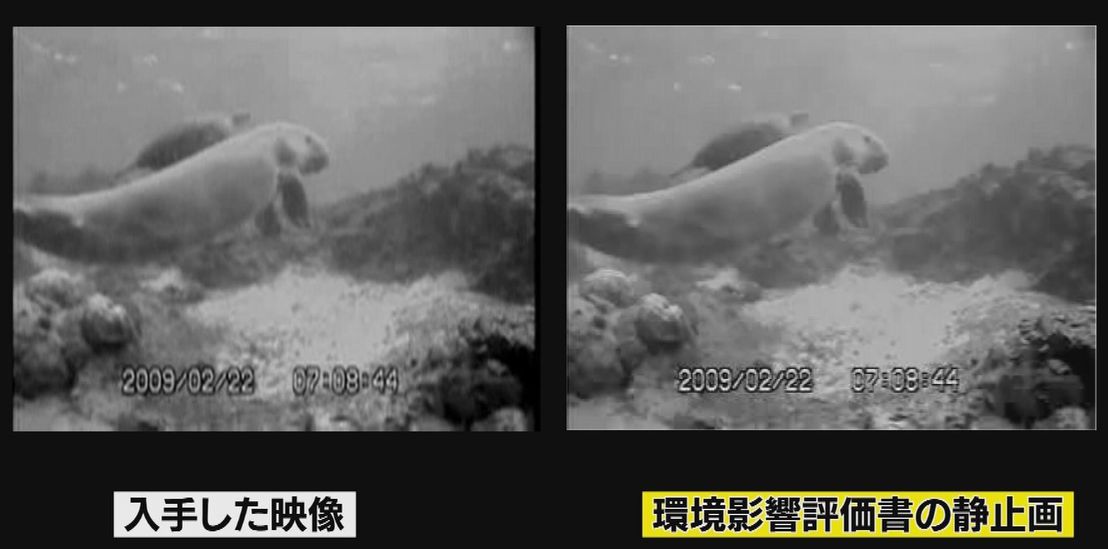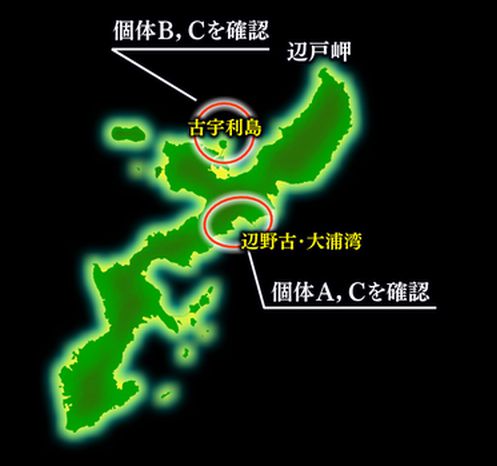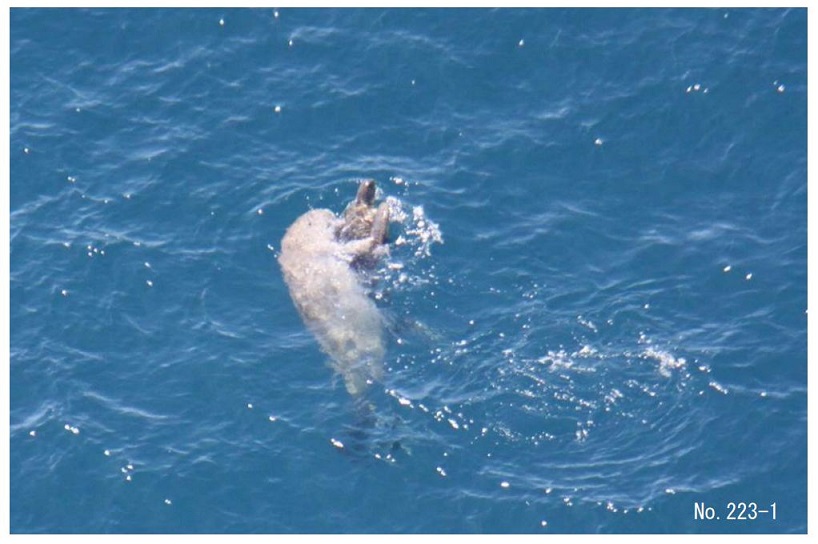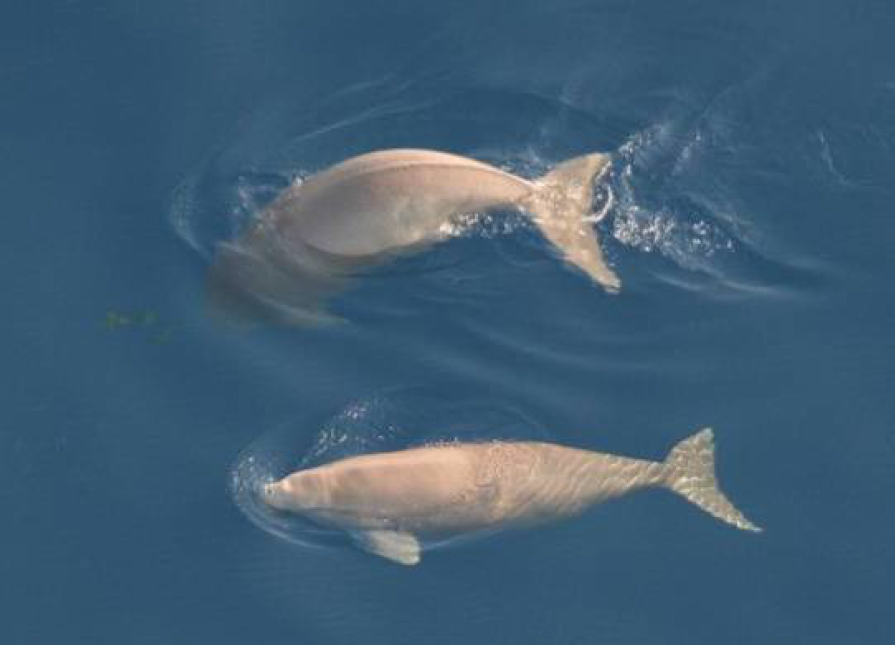The sea surrounding Okinawa is to be reclaimed to build a U.S. military base
2018年09月27日
This is the English translation of an article that first came out on WEBRONZA on Sept. 26.
Translation: Masami Ito
As I nervously pressed the play button, there it was – a dugong, designated by the Japanese government as a natural monument. It slowly appeared from the left side of the screen, its large body swaying from side to side.
It is said that the dugong inspired the legend of mermaids. However, the way it swam leisurely in the ocean was more heartwarming than beautiful. The dugong even had a sea turtle swimming next to it.
This is top-secret footage that I collected through my own reporting. It had been held from the public eye for a long time and I was eager to show it to the world. When I saw the animal floating about in the ocean with a sea turtle, however, my eagerness abated.
The water surrounding Okinawa is the world’s northernmost habitat for dugong. Only three have been confirmed to be living there now. There have been images of the dugong poking its head out of the water taken from aircrafts, but there has never been such a clear footage of the dugong swimming naturally underwater, until now.
The ocean where the dugongs live is facing uncertainty due to the construction for reclaiming land for the so-called new Henoko base to replace the U.S. Marine Corps Air Station Futenma.
According to the plan, about 160 hectares of the sea will be reclaimed, pouring 21 million cubic meters of soil and sand into the area. Once the massive base – which features two 1800-meter runways and a military port function - is completed, it is said that the base will also be equipped with 100 Ospreys.
The future of Okinawa and its surrounding waters is changing significantly.
The footage I obtained was indeed of the dugong swimming in the ocean around the Henoko area.
Dugongs are mammals that live in tropical and sub-tropical warm waters.
In 1890, the Ministry of Agriculture and Commerce reported that “dugongs in Amami and southward are not rare.” According to Okinawa Prefecture’s statistics, more than 300 dugongs were said to have been caught as a result of dugong hunting between 1894 and 1916. Furthermore, during the postwar period when Japan suffered from food shortages, dugongs were caught using handmade dynamite created from the gunpowder of unexploded bombs. In recent years, the number of dugongs has been decreasing, having lost their feeding ground of seaweed beds due to coastal reclamation and the inflow of red soil.
Ironically, a thorough research on the dugongs was conducted by noneother than the Okinawa Defense Bureau – an environmental assessment was carried out for the construction of the replacement facility of the Futenma base.
The Okinawa Defense Bureau presumed that there were three dugongs living in Okinawa. It named each dugong A, B and C, following their moving range as well as estimating their habitat and population. The bureau also looked into the use of the seaweed beds, the dugongs’ feeding ground, and examined whether or not the construction of the new base had any impact on the dugongs.
It looks like the footage I obtained was filmed when the Okinawa Defense Bureau conducted the environmental assessment because it completely matches the still image attached to the environmental impact report submitted to the Okinawa prefectural government in 2011.
The footage shows that it was filmed on Feb.22, 2009 at around 7 a.m. However, only a still image was attached to the environmental impact report. The footage showing the dugong swimming leisurely and the abundance of the Okinawa waters has been sealed from the public.
 The still image used in the Okinawa Defense Bureau’s environmental assessment report (right) and part of the footage obtained by Ryukyu Asahi Broadcasting (left), match perfectly. (Ryukyu Asahi Broadcasting)
The still image used in the Okinawa Defense Bureau’s environmental assessment report (right) and part of the footage obtained by Ryukyu Asahi Broadcasting (left), match perfectly. (Ryukyu Asahi Broadcasting)In the research conducted by the Okinawa Defense Bureau aircrafts (August 2007-November 2014) dugongs have been spotted 256 times around the Okinawan waters, of which Individual A was seen 143 times, B, 46, and C, 49. (Unknown: 18 times)
I showed the rare footage of the dugong in the ocean to Mr. Taro Hosokawa of the Dugong Network Okinawa, an organization that has long been active in protecting dugongs. When I initially told Mr. Hosokawa about the footage, he didn’t express much interest. Upon seeing the image, however, his expression softened and he broke into a smile.
“Wow, this truly shows that dugongs are living in the Okinawan waters. Unlike still images, it really is wonderful to see them alive,” Mr. Hosokawa said.
Mr. Hosokawa pointed out that the dugong in the footage was “Individual A” because of its trademark – a cut in his tail fin.
 Areas where dugongs Individual A, B and C were spotted (Ryukyu Asahi Broadcasting)
Areas where dugongs Individual A, B and C were spotted (Ryukyu Asahi Broadcasting)A is a male adult and is believed to be living on the east coast of Nago, close to the planned new Henoko base. During the day, it is floating about the water surface, believed to be resting. Toward the evening, it moves over to the coral reefs near Henoko, where it was believed to be eating the seaweed.
There was more information on the footage that matched the still image. The dugong could be seen often with a sea turtle. The attached photographs perfectly captured the dugong swimming with the sea turtle or hugging it.
It is said that there are only three dugongs in this vast ocean. Could it be that they think the sea turtles are their friends out of loneliness?
“That is just human imagination,” said Mr. Hosokawa, laughing at me. He points out that dugongs have been spotted swimming with green sea turtles in areas including the Philippines. “Perhaps they consider sea turtles to be friends because they both eat seaweed,” Mr. Hosokawa said.
Furthermore, Mr. Hosokawa noticed another unique characteristic of the dugong after seeing the clear underwater footage – A had something that looked like a hump on the right side of its back.
 A dugong, known as Individual A, seen playing with a sea turtle offshore Kayo in May 27, 2013 (Report on Schwab Water Area Creatures)
A dugong, known as Individual A, seen playing with a sea turtle offshore Kayo in May 27, 2013 (Report on Schwab Water Area Creatures)In June 2007, Ryukyu Asahi Broadcasting coincidentally caught two dugongs swimming near Henoko on camera. It was initially thought that the two were mating but it was later revealed that they were a parent and child. The dugong had given birth in the Okinawa sea and was raising a child there.
The dugongs on the footage are believed to be Individual B and C.
It is said that dugongs that move around in groups are often mothers and their children. That is why it was presumed that B was the mother and C, which is small with a black beauty mark-like spot on the top of its right foreleg, was the child. The two lived mainly on the west coast, around the waters of Kourijima. It has, however, been confirmed that they have traveled about 100 km over to the east side, by way of Cape Hedo (Hedo-misaki) the northernmost point on Okinawa Island.
When I first read the Environmental Impact Assessment report, it was difficult to understand and tiring just to read it. As I read on, however, I became excited by feeling that I was reading what was unknown to us - a record of a dugong family living in the Okinawa waters. And before I knew it, I was thinking I wanted to watch over this parent and child’s tranquil way of life.
Around May 2009, the child, C, began to go off on its own. It had grown into an adult and become independent from its mother.
 Two dugongs spotted offshore of Okinawa’s Kourijima (Okinawa Defense Bureau’s Environmental Impact Assessment report)
Two dugongs spotted offshore of Okinawa’s Kourijima (Okinawa Defense Bureau’s Environmental Impact Assessment report)C began to be spotted often on the east coast, away from the west coast where its mother lives. In September 2008, it was seen moving to the inner part of Oura Bay, just a stone’s throw away from Henoko, and in May 2010, it was spotted offshore Henoko. In research conducted in June 2009, feeding trails were spotted in the seaweed bed in Oura Bay, on the east side of U.S. military base Camp Schwab in Henoko, Nago City. The food trails were a little bit narrower compared to the others and it was believed to have been left by C.
Wasn’t Henoko an important place for Individual C? The Environmental Impact Assessment report, however, did not contain the details of C’s tracks in Henoko.
In regards to the impact that the new base would have on dugongs, the Okinawa Defense Bureau speculated that “the implementation of construction work will not affect the habitat, behavior pattern or feeding environment of each individual dugong living in Okinawa and there is very little possibility that it would impact maintaining the population of all of the dugongs living around Okinawa.”
There were also some accounts that could be seen as the bureau trying to cover its tracks in proceeding with the construction of the new base. It predicted that the dugongs would lose a part of their feeding ground in Henoko due to the reclamation but that it would not affect the dugongs.
It also stated that tankers are expected to be navigated into the new base but impact on dugongs can be avoided through measures to protect the environment, like ensuring that they would move slow enough to avoid crashing into dugongs.
The submission of this Environmental Impact Assessment report significantly progressed the construction of the new base. On Dec. 27, 2013, then Okinawa Gov. Hirokazu Nakaima declared the approval to reclaim Henoko.
Individual C, which the Okinawa residents had been watching over carefully, is now missing. In 2015, construction work began toward reclamation, including dropping massive concrete blocks into the Henoko waters. After June that year, Indvidual C suddenly disappeared.
I hope to follow up on this report in the near future.
 Part of the footage obtained by Ryukyu Asahi Broadcasting showing a dugong and a sea turtle swimming around the waters of Okinawa’s Henoko, where construction toward reclaiming the land to build a U.S. military base has begun.
Part of the footage obtained by Ryukyu Asahi Broadcasting showing a dugong and a sea turtle swimming around the waters of Okinawa’s Henoko, where construction toward reclaiming the land to build a U.S. military base has begun.
有料会員の方はログインページに進み、デジタル版のIDとパスワードでログインしてください
一部の記事は有料会員以外の方もログインせずに全文を閲覧できます。
ご利用方法はアーカイブトップでご確認ください
朝日新聞社の言論サイトRe:Ron(リロン)もご覧ください